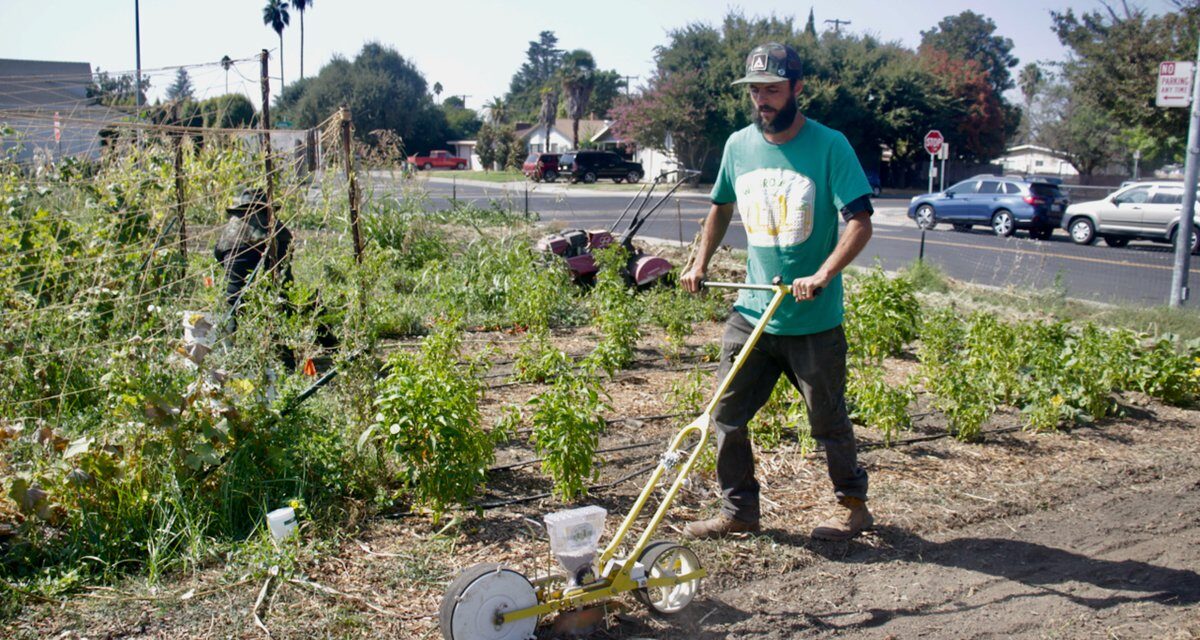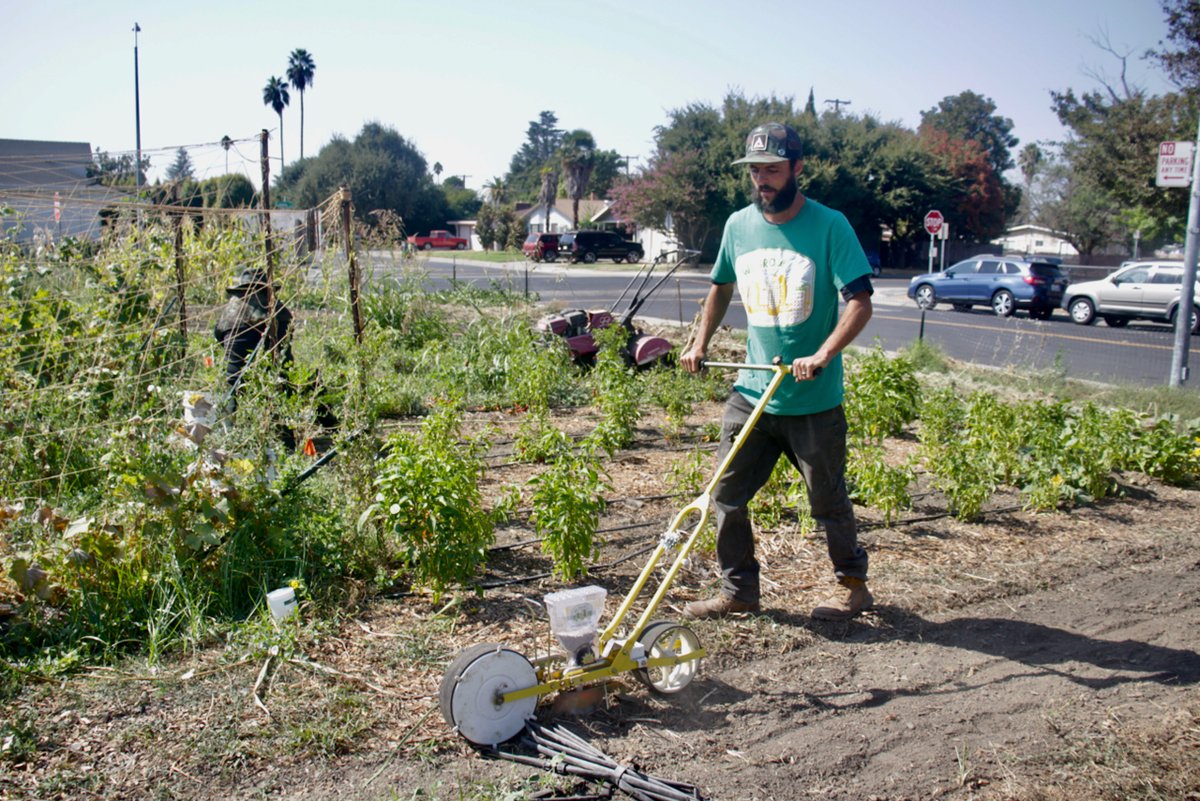Surrounded by low-income apartments, senior housing, and the cheerful hum of an elementary school playground, We Grow Farms is an unlikely yet central landmark in West Sacramento. Just a few miles from California’s state capital, owner Nelson Hawkins has turned an abandoned half-acre lot into a hub of food production for the community. Leased through the West Sacramento Urban Farm Program, the regenerative urban oasis attracts nearby residents, students, and plenty of honeybees.
After six years of enriching the soil and cultivating neighborly relationships, however, We Grow Farms is up against an insurmountable challenge facing many farms and pastures across the state: the real estate market. In the next year, the lot’s landowner, a developer, plans to turn the urban farm into affordable housing to feed an acute regional housing demand.
While Hawkins is sympathetic to the need, he says the farm’s uprooting will come at a great cost. He estimates that he has invested nearly $40,000 in soil improvements and irrigation infrastructure alone, and the loss will also impact the underserved communities We Grow supports.
As a Black farmer, Hawkins also provides a visible, powerful connection between food and its source, supplying the neighborhood with fresh produce such as collard greens, black-eyed peas, and tomatillos at its weekly, onsite farm stand. The rest is distributed to nearby urban and suburban areas in Yolo and Sacramento counties through food programs and community supported agriculture (CSA) subscription boxes—25 percent of it for free.
Small-scale farms are highly sensitive to the profession’s many challenges, including extreme weather, rising water and labor costs, and razor-thin margins. And for the majority that rent or lease their fields, the lack of long-term land stability can make farming “a David and Goliath battle,” Hawkins says—especially for growers who are Black, Indigenous, and people of color (BIPOC). Together, BIPOC growers own less than 2 percent of all farmland in the country.
But Hawkins, along with Nathaniel Brown and Keith Hudson—two other Black growers in the Sacramento River Delta—have a plan to address the disparity. As founders of the nonprofit Ujamaa Farmer Collective, the trio aim to strengthen the roots for historically underserved farmers by staking a cooperative claim to land ownership.
“You need at least $1 million to purchase farmland in California, and that doesn’t even include the tools, infrastructure, resources, and the labor.”
After persistent advocacy efforts by agriculture groups, the California legislature allotted a $1.25 million grant in 2022 to Ujamaa for the purchase of a medium-sized plot of land in Yolo County. The deed secures the tenure for multiple farms to operate on individual plots ranging in size from half an acre to 5 acres, each with a voice in collective governance and access to shared resources.
By building a resilient, worker-controlled network on secure soil, Ujamaa—which is named after a Swahili word for extended family and the fourth principle of Kwanzaa, embodying cooperative economics and advancement—will “elevate everybody’s potential so [we] can all thrive,” says Hawkins.
Agriculture-based collectives, such as farmer cooperatives and produce and commodity associations, are well-established in this country. Yet “they’re often white-led and they’ve had privilege,” including greater access to land and resources, says Brandi Mack, national director of The Butterfly Movement, an educational organization working to connect BIPOC women to the land through permaculture.
Mack is also a member of the People’s Land Fund, a collaborative that includes members from seven other social justice and agriculture nonprofits and is providing Ujamaa with pilot support, including pre-development guidance and starting capital.
Ujamaa’s purpose “is a different consciousness,” Mack says. Collective land ownership and governance set the course for “redistributing the flow to BIPOC farmers,” empowering them to build a more resilient community by amplifying their voices and “getting a leg up in the food sovereignty game.”
The Widening Historical Gap
California’s recent initiative is part of a larger state commitment that started in 2017 with the Farmer Equity Act, which aims to increase resource equity among historically underserved farmers. Other endeavors have included a $40 million allocation to Allensworth, the state’s first Black community founded in 1908, to invest in an organic farm and other enhancement, preservation, and planning projects, as well as land restoration for tribal communities.
“We’re trying to get away from the more colonial, extractive, and destructive systems that have shaped farming over the last 100 years.”
The efforts come at a crucial point for Black farmers, whose numbers have been on a precarious national decline over the last century. At their peak in 1910, African Americans made up around 14 percent of all U.S. growers and owned more than 16 million acres of land. Today, they make up just 1.3 percent of all farmers and own fewer than 5 million acres. The Golden State’s numbers are even more dire; the 2017 U.S. Department of Agriculture (USDA) census counted just 429 African Americans out of approximately 124,000 producers.
Meanwhile, national efforts to reverse disparities continue to fall short. Facing fierce political backlash, the 2021 American Rescue Plan Act—a debt relief program intended as restitution for decades of documented discrimination against Black and Indigenous farmers by the USDA— was rewritten to remove race from eligibility requirements. And recent reports also uncovered disproportionately high USDA loan rejection rates for BIPOC growers under the Trump administration.
For historically underserved farmers, land security is fundamental to leveling the field, says Jamie Fanous, policy director at the Community Alliance with Family Farmers, a nonprofit that advocated for Ujamaa’s legislative allocation. Yet intense competition for land in the state has widened the gap in farm ownership, she adds. Currently, more than half of the state’s cropland is held by 5 percent of landowners, while one-third of all fields and pastures are rented or leased out by non-farming landowners.




